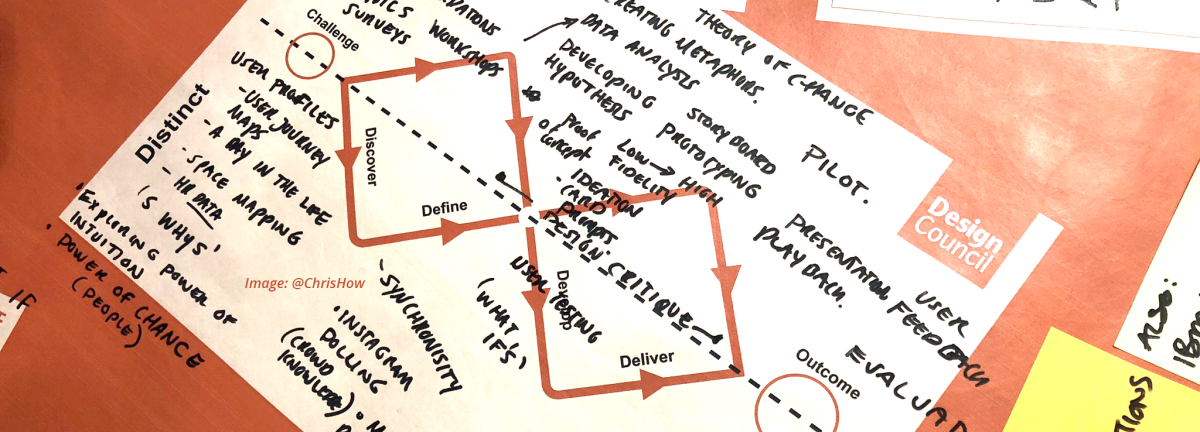A Framework for Designing the Future: Ellie Runcie, Chief Design Officer, BBC

2019 was a landmark year for design: 100 years since the Bauhaus set the foundations for modern design and 75 years since Churchill’s government established the Design Council to support post-war economic recovery.
Reflecting at the start of a new year and decade, the value of design has evolved significantly, as has its potential to play a more pivotal role in helping us to tackle contemporary economic and societal challenges.
Design Council continues to pioneer work demonstrating this. In 2005 they shared the globally respected and applied design process – the Double Diamond. And in 2019 it launched the Framework for Innovation – which keeps the Double Diamond at its heart, whilst greatly progressing it in response to the needs of a changing world.
Until summer 2019, I led the organisation’s innovation programmes, including its national Design Associate team, comprising design leaders across the UK, and was privileged to do so for 15 years. I have been reflecting on the road travelled to deliver this work, the key insights it unlocked and how these helped evolve the Double Diamond into the Framework for Innovation.
A methodology collaboratively developed with many
Our goal was to demonstrate the value of design where it was underutilised, to open up new opportunities for innovation. We supported thousands of businesses; hundreds of public sector professionals and entire communities dealing with pressing local issues. Inevitably, their needs and the resulting insights informed how we continually authored, adapted and adopted new approaches and elements.
A shift from product and service to systems-based challenges
The breadth and scale of challenges we supported shifted significantly after the Double Diamond was published, from: start-ups like Owlstone, working on technologies with potential to improve millions of lives; NHS Trusts like the Whittington, transforming critical services; communities such as Amble, reinventing their local economy; global manufacturers such as Rolls-Royce, exploring collaborative innovation across their supply chains; hundreds of students from universities across the UK; a region such as the South West coming together to collaboratively tackle the challenges of later life. This diversity informed a scalable methodology for design to tackle complex economic and societal issues.
The need to grow an evidence base
As Design Council’s programmes grew in scale and scope, so did an evidence base. Having supported 5,000 businesses through the design process we tracked their performance over a ten-year period. Some 91% continued to thrive and even outperformed a national control group by more than 40%. In our public and third-sector programmes, exploring and defining systemic problems required working more inclusively and collaboratively than ever. As change takes time, we found that building stories on this experience was a powerful way to inspire others to adopt this approach.
A challenge-led and outcomes-focused approach
Building a shared understanding of a problem before defining solutions remains vital yet challenging within innovation scenarios, so the Double Diamond remains core to the Framework for Innovation. As the trend for design thinking rose in recent years, we identified challenges with the methods-driven approach it can often promote.
We chose to focus more on the innovation process, to ensure we enabled people to rigorously explore their issues before translating insight into opportunities. A ‘learn by doing’ approach also embedded new skills in the people we supported, to confidently work with design to deliver change and ultimately create a positive impact.
Diversity and inclusion is core to design for change
Our approach enabled others to design with rather than for multiple stakeholders throughout the innovation process. Two elements encapsulate this. Engagement: including diversity of disciplines and lived experience of problems unlocks new ideas and gains buy-in, be it from senior stakeholders, employees, customers or communities. Leadership: providing a ‘safe space’ to those exploring problems and breaking through structural silos in or between organisations can transform culture.
What next for design?
The pace of development in the digital, biological and technological worlds are disrupting the way we work and live. Making sense of the challenges and opportunities to improve our lives requires organisations to adapt and adopt new ways of working to truly put the needs of their customers and communities at the heart of everything they do.
The 15-year journey to develop the Framework for Innovation has demonstrated this and also how design must continue to play a fundamental role in our lives, enabling us all to transform our future for the better.
I am delighted to see Design Council reach the age of 75 and treasure my memories of working there. Now, on my new design journey at the BBC, leading its award-winning User Experience and Design team I am excited to grow design’s value across the organisation to help drive its future success.
Subscribe to our newsletter
Want to keep up with the latest from the Design Council?
